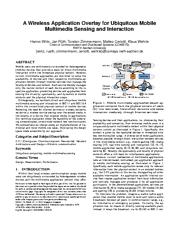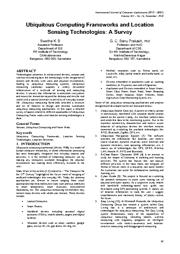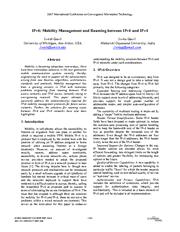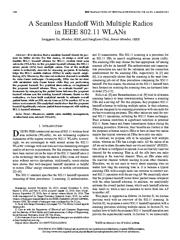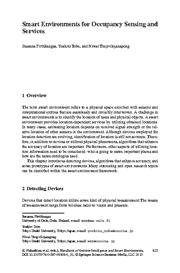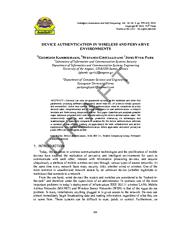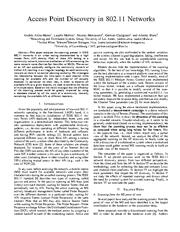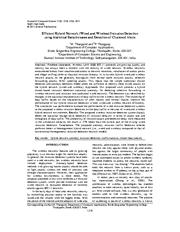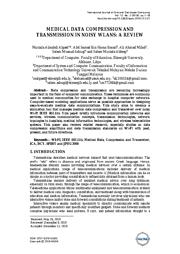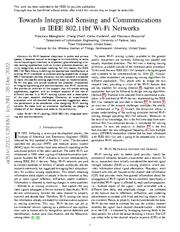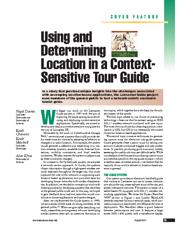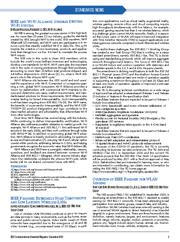A copy of this work was available on the public web and has been preserved in the Wayback Machine. The capture dates from 2017; you can also visit the original URL.
The file type is application/pdf.
Filters
A wireless application overlay for ubiquitous mobile multimedia sensing and interaction
2014
Proceedings of the 5th ACM Multimedia Systems Conference on - MMSys '14
Orthogonally, we facilitate direct and ubiquitous mobile multimedia sensing and interaction in 802.11 and 802.15.4 within the unrestricted physical context of mobile devices. ...
Removing the need for Internet services or wireless networks, we derive a wireless service overlay over the sensed media in the locality of a device that exposes media to applications. ...
Figure 14(b) ) for serving as a test subject in our face recognition evaluation. ...
doi:10.1145/2557642.2578224
dblp:conf/mmsys/WirtzRZCW14
fatcat:uus2arilc5fdxkfa6w67y3qaii
Ubiquitous Computing Frameworks and Location Sensing Technologies: A Survey
2018
International Journal of Computer Applications
In this paper a detailed survey of papers related to different approaches of Ubiquitous Computing Frame works and location sensing technologies is done. ...
Ubiquitous computing framework provides a structure and set of libraries to design and develop customized ubiquitous computing applications. ...
Monitoring when a mobile device is in range of one or more access points in a wireless cellular network is another implementation of the proximity location technique Active Badge Location System, Xerox ...
doi:10.5120/ijca2018918169
fatcat:iki35jjxgra2dkx43zsnmtgnku
IPv6: Mobility Management and Roaming between IPv6 and IPv4
2007
2007 International Conference on Convergence Information Technology (ICCIT 2007)
Mobility management has been a growing concern in IPv6 with numerous problems originating from roaming between IPv6 access networks and IPv4 access networks owing to ever-growing research. ...
arising from new theories, algorithms, architectures, standards and protocols. ...
A deployment such as this allow mobile nodes to security access IPpv4 services in the home network from IPv4 and IPv6 access networks. ...
doi:10.1109/iccit.2007.4420475
fatcat:f7yuhwumefenjeeuqzkfnwv4aa
IPv6: Mobility Management and Roaming between IPv6 and IPv4
2007
2007 International Conference on Convergence Information Technology (ICCIT 2007)
Mobility management has been a growing concern in IPv6 with numerous problems originating from roaming between IPv6 access networks and IPv4 access networks owing to ever-growing research. ...
arising from new theories, algorithms, architectures, standards and protocols. ...
A deployment such as this allow mobile nodes to security access IPpv4 services in the home network from IPv4 and IPv6 access networks. ...
doi:10.1109/iccit.2007.348
fatcat:cnjmivqrwjfa3d5n6tkmjxponi
A Seamless Handoff With Multiple Radios in IEEE 802.11 WLANs
2014
IEEE Transactions on Vehicular Technology
In the proposed handoff scheme, the 802.11 access points (APs) have multiple radios. One of the multiple radios is exclusively reserved for scanning purposes. ...
It is obvious that a seamless handoff should be pursued for better service. For this reason, we design a novel and feasible 802.11 handoff scheme for 802.11 wireless local area networks (WLANs). ...
Madwifi names MAC entities and radio objects after ath and wifi, respectively. Index numbers are assigned to the names on the order of MAC entity and radio object creations. ...
doi:10.1109/tvt.2013.2283914
fatcat:jwzbuzg5grdupifbey6sgrkrp4
Smart Environments for Occupancy Sensing and Services
[chapter]
2010
Handbook of Ambient Intelligence and Smart Environments
A challenge in smart environments is to identify the location of users and physical objects. A smart environment provides location-dependent services by utilizing obtained locations. ...
In many cases, estimating location depends on received signal strength or the relative location of other sensors in the environment. ...
For example, setting up a WiFi locating system requires installation of several access points and also, manual calibration of the map of the area and the corresponding signal strengths. ...
doi:10.1007/978-0-387-93808-0_31
fatcat:pbclrimyvvg3jbrgpbqkv5iv3q
Device Authentication In Wireless And Pervasive Environments
2010
Intelligent Automation and Soft Computing
We constructively argue on each solution presented examining its advantages and disadvantages. ...
Under this context, device authentication must be considered as a key security issue, complementary and of equal importance to user authentication, in today's wireless and forthcoming ubiquitous realms ...
Though, while location-based access control in human terms is straightforward, e.g., turning on the TV set in a particular room needs to have a physical presence in the room, achieving the same kind of ...
doi:10.1080/10798587.2010.10643089
fatcat:3scffeggbbad3f2kqwn6z7qlti
Access Point discovery in 802.11 networks
2014
2014 IFIP Wireless Days (WD)
This paper analyzes the scanning process in IEEE 802.11 networks in an urban setting characterized by a high Access Point (AP) density. ...
Most of these APs belong to a community network, known as a collection of APs announcing the same network name (Service Set Identifier or SSID). ...
ACKNOWLEDGMENT The authors would like to thank Tanguy Kerdoncuff and Nicolas Kuhn for their assistance and valuable comments on this paper. ...
doi:10.1109/wd.2014.7020817
dblp:conf/wd/Arcia-MoretMMCB14
fatcat:mwhodhowkbec3lxutmhhnx6usm
Efficient Hybrid Network (Wired and Wireless) Intrusion Detection using Statistical Data Streams and Detection of Clustered Alerts
2011
Journal of Computer Science
Wireless networks encountered threats from unauthorized access to network resources, installation of access points and illegal sniffing (refer as classical intrusion threats). ...
The detection was identified by changes in the statistical characteristics of data traffic on the wireless network. ...
Wireless threats such as attacks man-in-the-middle, rouge access points, war drivers and denial of service attacks function within the 802.11 frames and cannot be detected on layer three past access point ...
doi:10.3844/jcssp.2011.1318.1324
fatcat:b4cshluy4fba5d3jaz4tm6npja
Medical Data Compression and Transmission in Noisy WLANS: A Review
2019
International Journal of Grid and Distributed Computing
This paper briefly introduces communication networks and services, wireless communication concepts, transmission technologies, network topologies in hospitals, medical information technologies, and wireless ...
This paper also reviews related research, especially studies on data compression algorithms and data transmission standards on Wi-Fi with past, present, and future directions. ...
ACKNOWLEDGMENTS This research was funded by the Ministry of Higher Education Libya and Elmergib University. ...
doi:10.33832/ijgdc.2019.12.2.01
fatcat:qsycpadysrc5beigzcaobbwvl4
Towards Integrated Sensing and Communications in IEEE 802.11bf Wi-Fi Networks
[article]
2022
arXiv
pre-print
such as human presence detection, activity recognition, and object tracking. ...
We provide an overview of the support that will enable sensing applications, together with an in-depth analysis of the role of different devices in a Wi-Fi sensing system and a description of the open ...
We set up an IEEE 802.11ax network with two Asus RT-AX86U Wi-Fi access points (APs). ...
arXiv:2212.13930v1
fatcat:otpj2grtszdrtop7w7nfi3sg5i
Location Systems: An Introduction to the Technology Behind Location Awareness
2008
Synthesis Lectures on Mobile and Pervasive Computing
Instead, the modern localization landscape is a kaleidoscope of location systems based on a multitude of different technologies including satellite, mobile telephony, 802.11, ultrasound, and infrared among ...
The modern localization landscape is thus populated by a kaleidoscope of location systems based on a multitude of different technologies including satellite, mobile telephony, 802.11, ultrasound, and infrared ...
The table shows the service set identifier (SSID) of the wireless network to which the access point belongs, the MAC address of the access point, the received signal strength indication (RSSI) of the power ...
doi:10.2200/s00115ed1v01y200804mpc004
fatcat:cbvw7weeibhxjnbwnp4y4mat3m
Using and determining location in a context-sensitive tour guide
2001
Computer
THE GUIDE SYSTEM Our system provides an electronic handheld guide that visitors to Lancaster can use to access information about the city, create tailored tours of the city, and access interactive services ...
W e began our work on the Lancaster Guide project in 1997 with the aim of exploring the issues arising from developing and deploying context-sensitive applications. ...
The unit then provides route guidance to help users move between locations on the tour. • Access to interactive services. ...
doi:10.1109/2.940011
fatcat:b4edmgwcwrd55ejodu3eupq2l4
Policy-based self-management of wireless ad hoc networks
2009
2009 IFIP/IEEE International Symposium on Integrated Network Management
In the unlikely e v e n t that the a u thor did not send a c o m p le te m anuscript and there are missing pages, these will be noted. ...
This is the primary operation mode of 802.11, named Basic
Sei"vice Set (BSS) and typically used in wireless home networks and small WLAN deployments. ...
Independent Basic Service Set (IBSS) mode is the second mode of operation for 802.11 hosts,
defined in 802.11 standards as ad hoc mode [183]. ...
doi:10.1109/inm.2009.5188885
dblp:conf/im/HadjiantonisP09
fatcat:sdd6vgxcdnef5nztnfbnx245ni
Standards News
2020
IEEE Communications Standards Magazine
UWB's unique combination of precision and protection is likely to become the basis for secure access and location services of all kinds. ...
UWB shows promise for the evolution of secure transactions in mobile devices, by driving the convergence of hands-free access, location-based services, payments, identification, and device-to-device interactions ...
doi:10.1109/mcomstd.2020.9316644
fatcat:qbj3siwplrdtdcso36poptyj74
« Previous
Showing results 1 — 15 out of 928 results

